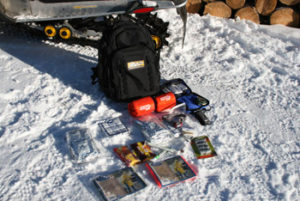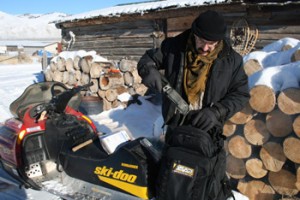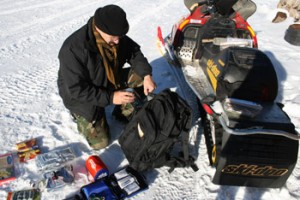
Dave Morelli explains how to make a winter bug-out bag (winter survival kit) in this feature from Gun Digest.

There is a lot of talk these days about putting together some sort of bug-out pack. I agree it is a good idea to be prepared for emergency, but there are a host of ideas as to what a bug-out pack is for.
Lots of folks think they could throw a minimal pack on their back, disappear from civilization and live happily ever after. The problem is only a few can do it. An argument could be made that the wise woodsman could make a living following these folks and using what they left behind after they expire. Whatever your reason is to bug out, having some minimal stuff and (most importantly) the knowledge to use it will be a deciding factor in your final outcome.
There are some good reasons to bug out and the bag should be planned for a particular reason. Still, there are some things that should be in any bug-out bag, no matter what, because these items are instrumental to survival.
Some sort of fire starter is paramount especially in cooler weather. It stays cold for a long time up here in the Idaho mountains. It may be spring where you are, right now, but I’m still looking at winter conditions, so I prepare for the worst. Water is also key, but it is heavy to carry. So you should carry come and plan to get more on the fly.
You’ll need enough food to get you by until you can find more. A good knife, a small hatchet, fishing supplies, some first aid stuff, a couple space blankets, some plastic garbage bags, (these can be used for a variety of functions) a GPS (and batteries) or a map and compass, flashlight (and batteries) and some method of purifying water. Some sort of firearm would make me feel better if I was stranded in the woods. If I was building a bag for the unlikely event of dealing with civil unrest, I would elevate the weaponry on the priority list.
But the reality is that you’ll be grabbing your bug-out bag to help you get out of the way of a violent storm or wildfire. Or you will have it in your vehicle in case you get stuck or stranded. This bug out would be a temporary situation and may only last until you could get to safety, are found by rescuers or in a serious situation, reach a gathering station displaced people.
Your location and community will play a big part in planning what to have in the bag. How long might you be on the move until you get to safety? What services are going to be available at that safe place? What time of the year will you be moving and how? Will there be obstacles along the way? (Bridges out, hostiles, unplanned challenging travel routes) No single bag set up could cover all the possibilities; so a bag that covers as many of the necessities for an estimated period of time to get to the next stage of safety is a good place to start. If your location leaves you with the possibility of being stranded for longer periods, you need to take this into consideration.
A situation involving a long stretch without power or road blockages thanks to storms could cause long delays in supplies getting to your area. Your bug-out bag may be better used to wait out the situation in your home. Hopefully, you have some emergency supplies for this situation but the bug-out bag still needs to be ready should some reason force you from the shelter.
There would be a ton of chatter if we started the discussion on which firearm to bug out with. I can already hear the gears turning. We all have a variety of firearms available and some are favorites we take everywhere we go. I would leave the firearm selection until I was running out the door. The situation or reason I was bugging out may play a big role in what type of firearm would be the better choice. I always have a handgun on me so I would imagine it would be coming along just because.
Will the bug out gun fill a defensive role or will it be used for food gathering? I realize that the roles are interchangeable but some guns are better for some purposes. More important is to consider what would be the best for a variety of situations and which one you will grab without too much thought as the disaster happens.
As important as a defensive firearm is, the risk of starving to death or succumbing to exposure is probably more of a threat than getting into a firefight with a panic-stricken mob, especially if you use some evasive tactics in your bug out.

Planning with the Rule of Threes in mind will help you prioritize. You can live three minutes without air, three hours without shelter, three days without water, three weeks without food, and three months without sex. I am living proof you can stretch the three months out much longer.
I believe the minimum bug-out pack should have at least three days or 72 hours of supplies for each member of the family. I would also put my areas of importance based on the Rule of Threes, even though that’s more of a survival priority, it puts things in perspective. When the situation deteriorates, like situations often do, three days of water will get you farther than all the food in the world.
You can put your bug-out bag together from scratch in a quality pack or you can buy the ready-made bag. Another option is to buy the ready bag and add to it. The problem with buying the ready bag is you don’t really know if the gear will be adequate until it is too late and if you use the ready bag to test it out you will have to replace the contents before you need them.
The pre-made bag is not a bad place to start and you can always tailor it to more closely fit your conditions. I checked out a bug-out bag from ASAP Survival Gear. They have many selections but this was a 72-hour, two-person bag. It comes with a lot of necessities but also includes a book and CD called Your Survival by Dr. Bob Arnot. This book and CD will definitely add to your knowledge when you are adding to your bag. It goes over many types of disasters and gives you an idea of what might be important to have in that situation.
The supplies come in a pack that I really liked. The pockets and zippered pouches were of adequate size and positioned for efficient utility. Things that you might want to access quickly without digging through the pack like a GPS can be kept in a properly sized pocket. It also had a generous amount of extra room for additional supplies like clothes, medications, and extra food. This bag is designed for the scenario where you are leaving on foot or it can accompany the other supplies packed in a truck or SUV bug-out vehicle.
The bag also comes with a multipurpose radio powered by a solar panel or a crank that can be used as a cell phone charger. The unit also has a light that is powered by the crank or the solar panel and has several weather channels.
Also in the bag is a water bottle, space blankets and individual shelters, headlamp, fire starter, a complete first-aid kit, ponchos, and a Bushnell Backtrack GPS. The first aid kit is well stocked and has some common medications you would use in the field. Along with common first-aid items there is a book on wilderness medicine and a small roll of duct tape. There is also room to include personal medications. Light is always a useful commodity and the kit has several light sticks for instant light and a Leatherman Super Tool for common chores.
The kit comes with a 72-hour supply of food and water for two people. The water is in 4-ounce foil envelopes, 36 to a bag. That’s roughly 144 ounces of water for two people for 72 hours. I think it would work out a little light for two people over 72 hours and I would carry more water or at least have a plan to get it on the move. The bag also has a 32-ounce water bottle from Camelbak that can be filled and refilled when water comes available. Remember, you’ve only got three days without water.

The food contained in the pack made up of cubes best described as a food-like substance. But is actually tastes pretty good. The ration calls for one cube three times a day. Each bar provides 400 calories, giving you 1,200 calories per day.
I would imagine it would be enough to survive on but I would add some munchies to my bag. MRE’s or food from the grocery store in aluminum envelopes instead of cans would last a long time and would add some enjoyment to surviving. If you went with the supermarket type you could buy MRE heaters to warm them up if you couldn’t make a fire.
There are a variety of long-lasting snacks that can be added to this bug-out bag and it is big enough to accommodate some extra rationing. I would also try to put a change of clothes in the bag and maybe some extra socks and gloves. There may be other medications and supplies that will be needed for each individual according to the circumstances.
You can also set up a bug-out bag from scratch, tailoring it to your specific purpose. For me it would have to be a dire circumstance for me to leave my home on foot, especially in winter. It is just too far to go to get anywhere that would be safer. I most likely will be leaving in a vehicle and will have the luxury of packing a little heavier.
A duffle bag with clothing and food and several cases of bottled water are in my storeroom ready for a bug out. These supplies need to be kept in a safe place and easily retrieved when it is time. Although the food should be rotated for freshness, the supply should be separate from the regular pantry. This will assure the rations will be adequate when the emergency unfolds.
Just because we call it a bug-out bag doesn’t mean we have to leave our homes to be safe. The idea of the bag is to have some motility in case the best thing to do is get moving. The idea is to be ready for a catastrophe that might keep you from getting to the store.
I live in a remote place and it is common to always have a little more supply in case a winter storm keeps us from the market or the power goes down for a few days. We live on the end of the grid and it is not uncommon to lose power here. Being prepared means having the things needed to survive through an interruption of necessary services. It is also good to include bugging out as part of that plan.
Whatever the situation that presents it is wise to consider the circumstances that might apply to the area in which you live and prepare for them. Having supplies on hand for a minor emergencies is a good start but disasters happen quickly and without notice.
Having a plan can mean the difference between life and death should the poop hit the propeller. Whatever your bug out vehicle is, foot or motor, set up and give some thought to the things that will come in handy. Have them where they can be loaded up quickly.

Next Step: Get your FREE Printable Target Pack
Enhance your shooting precision with our 62 MOA Targets, perfect for rifles and handguns. Crafted in collaboration with Storm Tactical for accuracy and versatility.
Subscribe to the Gun Digest email newsletter and get your downloadable target pack sent straight to your inbox. Stay updated with the latest firearms info in the industry.

![Best Concealed Carry Guns In 2025 [Field Tested] Wilson Combat EDC X9S 1](https://gundigest.com/wp-content/uploads/Wilson-Combat-EDC-X9S-1-324x160.jpg)


![Best 9mm Carbine: Affordable PCCs [Tested] Ruger Carbine Shooting](https://gundigest.com/wp-content/uploads/Ruger-Carbine-Shooting-100x70.jpg)
![Best AR-15: Top Options Available Today [Field Tested] Harrington and Richardson PSA XM177E2 feature](https://gundigest.com/wp-content/uploads/Harrington-and-Richardson-PSA-XM177E2-feature-100x70.jpg)

I agree with both reviews ,health concerns would most likely put me in a vehicle .Staging areas for fuel and at least two final destinations are some logistics I’m trying to work on .How long can you store gasoline ???
Nothing is to much to put in your bug out bag, as long as u can handle it without help. I prefer to bug out in a vehicle of some kind. Therefore the heavy BOB is not a problem. First aid kit, MRE’s, knives, various weapons including a pair of 45ACP’s, 30/30 cal hunting rifle & scope. My M1 30 cal rifle and various other firearms. Warm clothing, shelter devices. I am somewhat parinoid and beleive in lots of firepower.
Mike
I have issues with this “adaptation” of the law of three. It was originally just three by three, three minutes without air three days without water and three weeks without food. Period. A 3×3 matrix or three cubed. Somebody thought they were cute and added the bit about shelter and are WRONG. There is no absolute when it comes to shelter. It depends on climate and clothing. Including it in this manner has caused so many peope to Frankestein up a Bug out bag it is ghastly (pun intended). I have seen bags so heavy that they nearly triple the energy expended to move about just because of the added weight. Shelter is a “situational situation” just like a firearm. If you will be traveling by motor vehicle, where it is less critical, it is easiest to bring portable shelter, by foot, not so much but it will be needed much more, as you wont have the interior of the car/truck to protect you from the elements. YET, this is the most neglected area of education in this topic. Few people study how to make a shelter out of what is available in the local AO… and less how to choose what to carry to make one OR what clothing to wear to eliminate the need for one for the most part. I have well over 40 years personal experience in living of the land, and minimalist survival techniques. WE need to instill the ideology that the Bugout bag is not a portable Winnebago, and that it is secondary to knowledge and skills that are learned and practiced ahead of time. I commend you for sticking to the premise of not overloading the “BOB”… And I look forward to seeing more of your work on this subject, as I finally have found someone I can point others to and tell them that I am not talking off the top of my head when I tell them that a 99 pound bug out bag is unrealistic.